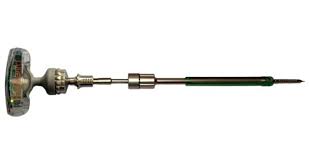 SPINEGUARD COMPLETES FINANCING FOR “SMART” SCREW (Orthopedics This Week)
SPINEGUARD COMPLETES FINANCING FOR “SMART” SCREW (Orthopedics This Week)
SpineGuard, S.A. has finished raising the rest of a $3.1 million equity round of financing to accelerate the market launch of its “smart screw” for spine surgery.
Claiming to have the world’s first “smart screw” to make surgery “safer,” the company said on June 15, 2015 the equity came from two Paceo equity line draws in April and May. In addition to a private placement with institutional investors announced in June, the company issued new shares to investors.
“Despite the cancellation of the public offering announced by the company on June 4 due to adverse market conditions, the company was able to serve most of the subscription demands received. Pursuant to article L. 225-138 of the French Commercial Code, this equity round was reserved for named investors meeting certain criteria as defined in resolution 13 of the shareholders’ meeting of May 28, 2014,” stated the company.
The company was co-founded in 2009 in France and the U.S. by Pierre Jérôme and Stéphane Bette. The co-founders’ goal is to establish its proprietary Dynamic Surgical Guidance (DSG) technology as the global standard of surgical care, initially for safer screw placement in spine surgery and then in other surgeries. The first products using the DSG technology, PediGuard, was co-invented by Maurice Bourlion, Ph.D., Ciaran Bolger, M.D., Ph.D., and Alain Vanquaethem, Biomedical Engineer.
PediGuard, according to the company, is the world’s first and only handheld device capable of alerting surgeons to potential pedicular or vertebral breaches. Over 38,000 surgical procedures have been performed worldwide with the device.
Audio Feedback
The device works by provides audio feedback to the surgeon.
As the probe is inserted past the entry point into the pedicle, according to the company, a high pitch and high cadence feedback might be heard. This is due to the tip being advanced past the blood collected at the entry point.
“A mid-range pitch and medium cadence audio signal can be heard as the probe is being advanced into the pedicle through cancellous bone. A small decrease in cadence and pitch can be discerned as the probe is advanced past the isthmus in the pedicle. The audio signal will return to medium pitch and medium cadence once the tip is in the vertebral body. As the probe is being retracted from the pedicle, a high cadence and high-frequency audio feedback should be expected—this is due to the blood around the tip of the probe.”
In 2015 SpineGuard started to expand the applications of DSG into pedicle screws through partnerships with surgical companies in France and the U.S.

 Tiger Buford – retained recruiter dissecting orthopedics
Tiger Buford – retained recruiter dissecting orthopedics